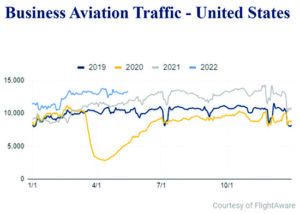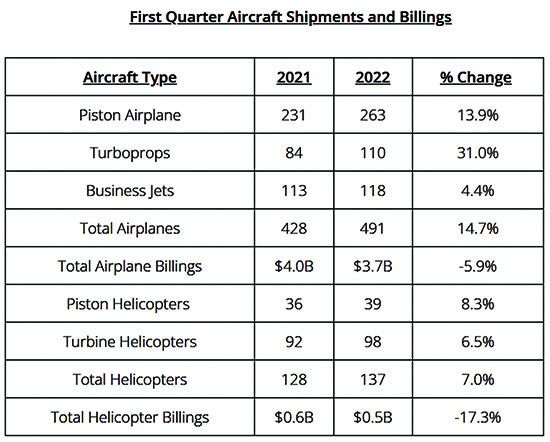The aircraft manufacturing industry’s results for the first three months of 2022, when compared to the same period in 2021, point to increasing aircraft unit deliveries across each aircraft segment while the overall value of the aircraft shipments was slightly lower.” So said the General Aviation Manufacturer’s Association (GAMA) in mid-May on the occasion of releasing 1Q 2022 sales and billing numbers for the industry it represents.
“It is reassuring to see aircraft deliveries continue to show strong progress as we emerge from impacts of the pandemic,” said GAMA President & CEO, Pete Bunce. “It is especially encouraging to see piston airplane deliveries continue their positive trajectory and exceed last year’s numbers as well as the first quarter numbers of 2020 and 2019,” he added. The chart below highlights the sales and billing numbers that GAMA published
The sales data GAMA compiled is reflected throughout the general and business-aviation community as it and the rest of the world’s economies continue recovering from the pesky Covid-19 pandemic. Business aviation’s activity levels are up when compared even to 2019’s numbers, with the North American charter market “particularly hot,” according to the industry analysts at WingX. Flights are up 31 percent versus May 2019. WingX adds that, globally, “So far this year, business aviation sectors are up by 15%, up by 20% if turboprops excluded, all compared to the same January through May period of 2019.”
Although GAMA’s Bunce atttributes at least some of his industry’s sales growth to “the regulatory reforms undertaken by several regulatory bodies that enable new technology and new aircraft and entrants,” it’s not at all clear any recent regulatory changes are responsible. For one reason, there really haven’t been any “recent” changes. For another, even if there were, it takes time for such upheavals to ripple through the certification and production process. Instead, it’s most likely pent-up demand for business travel and the continuing unpleasantness of doing it on the airlines.
For comparison, the U.S. Transportation Security Administration is reporting daily passenger screening counts at 92.7 percent of 2019’s numbers. More data, from FlightAware.com, summarized in the chart on page 32, reflect the same gangbusters attitude many in the industry are enjoying.
For another data point, Bombardier in May announced its newest large bizjet offering, the Global 8000, slated to enter service in 2025. According to the company, the Global 8000 will be the “world’s fastest and longest-range purpose-built business jet,” with a top speed of Mach 0.94 and range of 8000 nm, though perhaps not at the same time. Gulfstream, Bombardier’s main competitor in the large-cabin bizjet market, previously announced its G800, advertising the same 8000-nm range, albeit with a slower maximum speed, Mach 0.925. Gulfstream plans a 2023 entry into service.
As GAMA’s numbers illustrate, other aircraft also are in demand and selling well. Clearly, the general aviation industry is enjoying some good times, with activity and sales up pretty much across the board. This comes at a time when worldwide economic woes, including supply-chain issues and inflationary pressures, continue shifting the landscape. And I haven’t even mentioned spiraling prices for both aviation gasoline and jet fuel.

In contrast, the airline industry faces a number of challenges. Unruly passengers, varying mask mandates, pilot shortages and labor unrest are among them. Carriers like Skywest are ending service to 29 cities this spring, all of which were served under the U.S. Department of Transportation’s essential air service program, which subsidizes smaller communities. According to Airline Weekly, “The regional carrier…blamed the worsening pilot shortage for dropping the routes.” Did I mention fuel prices?
And we haven’t even gotten to the ongoing fallout from Russia’s Ukraine invasion and the continuing economic upheavals that have resulted, and which may grow and expand to encompass industries sectors beyond energy, wheat and armaments. Beyond the war in Ukraine, the International Monetary Fund’s World Economic Outlook Global growth projection is for the economy to slow from an estimated 6.1 percent in 2021 to 3.6 percent in 2022 and 2023. “This is 0.8 and 0.2 percentage points lower for 2022 and 2023 than projected in January,” the IMF said. “Beyond 2023, global growth is forecast to decline to about 3.3 percent over the medium term,” it added
All in all, the big picture tells us to be cautious when making multi-year decisions or career choices. For example, while new pilots may be in strong demand right now, the aviation industry’s cyclic nature means that could change almost overnight. In fact, it did change overnight in early 2020 when the Covid-19 pandemic took hold.
All of this is preamble to say this: Aspiring pilots should be fully aware of what they’re getting into.
— Jeb Burnside




